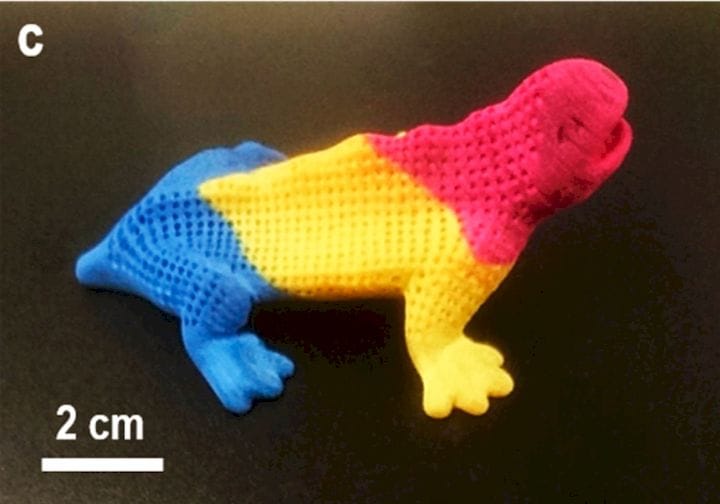![Brilliantly dyed SLS 3D prints using a new method of producing white objects [Source: ACS]](https://fabbaloo.com/wp-content/uploads/2020/05/image-asset_img_5eb0a88aef83d.jpg)
Researchers at The Barcelona Institute of Science and Technology have developed a method that may lead to full color SLS 3D printing.
SLS-style 3D printing has been around nearly forever, at least in the few decades of the technology. It involves using a flat powder bed of fine thermoplastic powder, which is selectively sintered using a heat source, typically a powerful laser. The laser traverses the surface, solidifying the appropriate sections of each layer.
The problem with this approach has been one of power. In order for the laser to bring the powder area to a sufficiently high temperature, energy must be absorbed by the material. Earlier SLS systems use powerful CO2 lasers that can deliver a great deal of energy. But they are bulky and expensive.
More recent SLS machines employ an interesting trick: they use dark-colored powder, which absorbs energy more easily. This means they can design 3D printers that use far less powerful lasers, lowering the manufacturing and purchase prices.
But the problem with dark colored powder (typically black or at least gray) is that you get dark colored prints.
These dark colors make the parts nearly impossible to dye. White parts made by more powerful machines are typically dyed to achieve specific color variants. But not so with darker parts.
However, the researchers here developed a new approach that involves a uniquely designed powder material. Their experimental powder is able to absorb significant laser energy, while remaining mostly unaffected at visible wavelengths. This means that the laser can heat the powder as efficiently without requiring the dark color.
Their experiments show that the approach does work, although they don’t explain the likely production cost of such a material. It could be pricey, as one of their formulations includes actual gold! They explain:
“In the present work, we demonstrate the use of gold nanorods (GNRs) as NEPS, allowing the production of white or brightly colored 3D parts via selective sintering with low- power diode lasers.”
![Overview of an experimental process to 3D print far whiter objects [Source: ACS]](https://fabbaloo.com/wp-content/uploads/2020/05/image-asset_img_5eb0a88b64ab7.jpg)
Regardless of the future potential cost, the results of their work enable a “magic” 3D printing powder that can be used in low-power SLS 3D printers and at the same time be capable of being dyed to any desirable color. Note the brilliance of the sample dyed prints at top.
This process is definitely not a means of doing full RGB color SLS 3D printing, but it could be a step towards that eventual goal.
I suspect once the “white” material approach is achieved, it may be possible to integrate a color inkjet head into the process. Just as the layers of powder are selectively solidified, they could also be “inked” with the right combination of primary colors to achieve any desired color. This inking would have to survive the hot fusion process, however.
But that’s a future we haven’t seen yet. And we also haven’t seen the future of even this research yet: it’s only research and there is no word on whether this technology will make it into the commercial world. However, it’s benefits are such that I suspect it won’t be too long in coming.
Via ACS











Formlabs just issued three new videos for beginners to 3D printing, and the result was quite surprising.